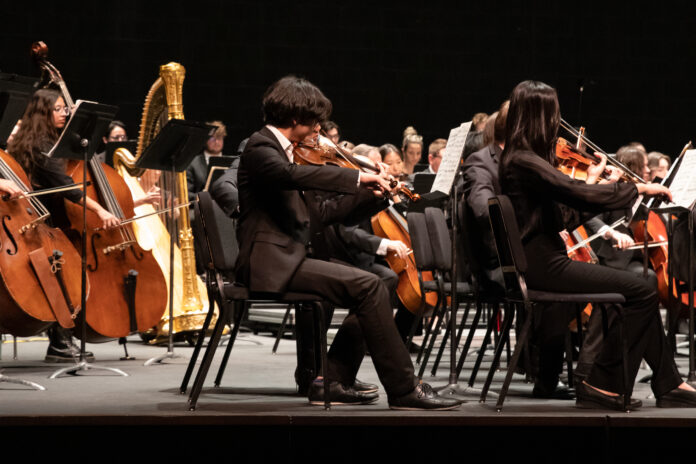“You go there, close your eyes, and you feel like you’re in a dream. The experience is out of this world,” said Ahmed Saleh, an attendee of the UNLV Symphony Orchestra’s first performance of the semester. The performance was conducted by Music Director Taras Krysa and featured flutist John McMurtey as the star for the second part of the program at Artemus Ham Hall on Sept. 27.
The orchestra first played “Overture to Rienzi, WWV 49” by Richard Wagner. The overture opened with a single-string instrument playing long, lingering notes. Then, a cluster of strings joined, playing a wistful melody, and soon after, another cluster of strings harmonized with the first group of strings. Towards the end of the overture, the orchestra ramps up, oscillating between playful melodies and dramatic motifs. During the playful and lively moments, the percussion and the triangle stole the show. During the final dramatic moments of the overture, a violinist played so intensely that they almost fell out of the chair.
The second part of the program is the “Flute Concerto No. 2 in D Major, K. 314” by Wolfgang Amadeus Mozart. On the flute, McMurtery moved through the high and low pitched notes fluidly. McMurtey swayed with the music, mesmerizing the audience. The orchestra accompanied McMurtery at times, and in brief moments, they let McMurtery shine in his solo melodies. As the second part of the program ended, McMurtery received flowers and resounding applause as intermission began.
After intermission, the final part of the program begins, Ludwig Beethoven’s “Symphony No. 5 in C Minor, Op. 67.” The first movement, “Allegro con brio,” is most known for its famous four-note motif. The motif consists of three short notes and one long note that opens the symphony. Krysa says, “Beethoven is one of the most well-known composers and [the Fifth Symphony] is one of the most well-known pieces. It’s great learning material for the students to learn style and precision.” At the end of the performance, the audience gave the performers a standing ovation for over five minutes as each section of the orchestra: the woodwinds, brass, percussion and strings bowed.
Ahmed Saleh, a pre-nursing student, attends UNLV Orchestra performances regularly. “The first concert I attended was the Vivaldi one [referring to UNLV Chamber Orchestra’s Four Seasons performance in May 2022]. It was my second semester at UNLV and I heard about it through email announcements. Ever since then, I think I’ve been to 10 [performances] in total. Students should go because it’s very relaxing and therapeutic.”
At the same time, Krysa emphasized the value of participating in the orchestra, saying, “Playing in an ensemble is one of the most important skills students learn. It’s all about collaboration and we’re constantly interacting with each other, with the audience, the composers and ourselves. It’s a learning curve for everyone, no matter what experience or skill they have.”
For all orchestra performances, tickets are free to students with a valid RebelCard. UNLV faculty and staff, seniors and military members receive discounted tickets. UNLV Symphony Orchestra will perform works by Ukrainian composers Lyatoshynsky and Skoryk on Oct. 25. On Nov. 21, they will be playing Brahams’ “Schicksalslied” in collaboration with the UNLV Choir.

